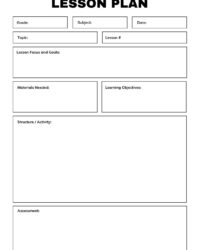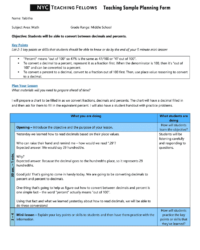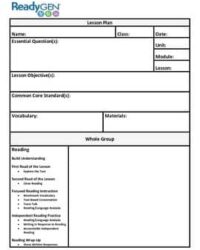Ever feel like you’re reinventing the wheel every time you sit down to plan a lesson? You’re not alone! Educators often spend countless hours crafting lessons from scratch, meticulously detailing objectives, activities, and assessments for each new topic or class. While dedication to planning is admirable, the repetitive nature of the task can quickly become a significant time drain, pulling valuable energy away from actual teaching and student interaction.
Imagine having a robust framework that guides your planning process, ensuring consistency, saving time, and maintaining high quality. That’s precisely the power of developing a lesson plan template. It’s not about stifling creativity; it’s about streamlining the foundational structure so you can pour your creative energy into the unique content and delivery for each lesson. Think of it as building a customizable blueprint that you can adapt again and again, leading to more efficient and effective teaching.
Why a Dedicated Template is Your New Best Friend
A well-crafted lesson plan template does more than just save time; it elevates the entire planning experience. It provides a consistent structure that ensures you hit all the necessary points, from learning objectives to differentiation strategies. This consistency isn’t just for your benefit; it also makes it easier for substitutes to follow your plans, or for colleagues to understand your pedagogical approach if you ever share resources. It transforms planning from a daunting blank page into a guided, productive session.
Furthermore, a template acts as a mental checklist, preventing oversight of critical components. In the hustle of daily teaching, it’s easy to forget a small but important detail, like a check for understanding or a clear transition. By having these elements pre-built into your template, you’re prompted to consider them every time, leading to more comprehensive and thoughtfully designed lessons. This structured approach fosters a higher level of precision and professionalism in your instructional design.
Key Elements to Consider When Developing a Lesson Plan Template
When you embark on developing a lesson plan template, think about what truly matters for effective teaching and learning in your specific context. Different subjects, grade levels, and even individual teaching styles will necessitate variations, but some core components are universally beneficial. These elements form the backbone of a successful lesson and should be prominently featured in your customizable framework.
- Learning Objectives: Clearly stated goals for what students should know or be able to do by the end of the lesson.
- Materials and Resources: A comprehensive list of everything needed, from textbooks and technology to manipulatives and handouts.
- Procedures/Activities: A step-by-step outline of how the lesson will unfold, including teacher and student actions.
- Differentiation Strategies: Notes on how to adapt the lesson for diverse learners, including support for struggling students and enrichment for advanced ones.
- Assessment/Checks for Understanding: Methods to gauge student comprehension throughout and at the conclusion of the lesson.
- Homework/Extension Activities: Assignments for practice or further exploration beyond the classroom.
Tailoring Your Template to Your Unique Needs
The beauty of developing a lesson plan template yourself is the ability to perfectly align it with your unique teaching philosophy and practical requirements. Don’t be afraid to experiment with different layouts or add sections that are particularly important for your subject area. For instance, a science teacher might include a dedicated section for safety procedures, while a language arts teacher might add a section for specific vocabulary acquisition strategies. The goal is to create a living document that evolves with your experience and pedagogical insights, truly becoming a reflection of your best teaching practices.
Steps for Building Your Ideal Template
Embarking on the journey of creating your template might seem like another task, but it’s an investment that pays dividends. Start by gathering examples of lesson plans you’ve found effective in the past, or even templates shared by colleagues. Identify the common threads and the elements you consistently use. Then, think about what you often forget or wish you had included – these are prime candidates for dedicated sections in your new framework. The first draft won’t be perfect, and that’s entirely okay.
- Review Existing Plans: Look at your most successful lesson plans. What sections do they all have in common?
- Identify Core Components: List the essential elements that every one of your lessons must include (objectives, materials, activities, assessment).
- Consider Your Context: Add sections specific to your subject, grade level, or school requirements (e.g., cross-curricular connections, technology integration).
- Design the Layout: Decide on the visual organization. Will it be a table, a list, or distinct sections? Make it easy to read and fill out.
- Pilot and Refine: Use your new template for a few lessons. Note what works well and what feels clunky or missing.
- Iterate and Improve: Adjust the template based on your experiences. It’s a dynamic tool that should grow with you.
Once you have a working draft, the real magic happens in its application. Use your template for a few weeks, and pay close attention to how it streamlines your planning process. Are there sections you consistently leave blank? Perhaps they aren’t as crucial as you thought. Are there elements you always manually add that should be part of the template? Don’t hesitate to make adjustments. This iterative process of using, evaluating, and refining is key to creating a truly effective and personal tool.
Ultimately, a well-designed lesson plan template becomes an invaluable asset, transforming your preparation from a chore into a focused and efficient process. It frees up mental bandwidth, allowing you to dedicate more creative energy to crafting engaging activities and responding to student needs. By investing time in developing a lesson plan template, you’re not just saving future hours; you’re actively enhancing the quality and consistency of your instruction, creating a more impactful learning experience for everyone in your classroom.
Having a structured approach to lesson preparation also brings a sense of calm and control to your teaching life. No more last-minute scrambling or wondering if you’ve forgotten something vital. Your template provides a reassuring framework, ensuring that every lesson, whether a complex unit or a simple review, is built on a solid foundation. This confidence translates directly into the classroom, allowing you to focus on delivery and student engagement rather than remembering the next step in your mental outline.
So, take the initiative to craft your ideal planning companion. It’s a powerful step toward not just better lessons, but a more organized and fulfilling teaching journey. Embrace the efficiency and clarity it offers, and watch how it transforms your approach to instructional design, making every teaching day more effective and less stressful.


